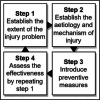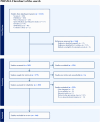The Consistency of Primary, Secondary and Tertiary Prevention Definitions in the Context of Musculoskeletal Sports Injuries: A Rapid Review and Critical Exploration of Common Terms of Usage
- PMID: 40102364
- PMCID: PMC11920493
- DOI: 10.1186/s40798-025-00823-y
The Consistency of Primary, Secondary and Tertiary Prevention Definitions in the Context of Musculoskeletal Sports Injuries: A Rapid Review and Critical Exploration of Common Terms of Usage
Abstract
Background: Formal statements articulating the meaning of primary, secondary and tertiary prevention concepts are commonly used in the musculoskeletal sports injuries literature, but appear to be employed inconsistently and incorrectly. Standard definitions, appropriate to athletic health and performance practice, are required to systematically develop the state-of-the-art. To accomplish this, we summarized prevention definitions with the aim of improving conceptual clarity across the musculoskeletal sports injuries literature.
Main body: We used a rapid literature review method, searching Scopus, PubMed/Medline, Cochrane Library reviews/trials, Web of Science, Sports Medicine and Education Index, SPORTDiscus and CINAHL databases for titles/abstracts for available literature, published in English from database-inception to November 2023. Our search terms were: sport/athlete, injury, primary prevention, secondary prevention, and/or tertiary prevention. Definitions were extracted to create categories illustrating overlap and variation. We extracted definitions from 144 included studies (n). Primary prevention appears focused on mitigating injury risk (n = 52) and preventing initial injuries (n = 42). Secondary prevention appears to address five distinct concepts: preventing recurrences (n = 42), preventing sequelae (n = 41), preventing index injury worsening (n = 27), mitigating injury risk (n = 15), and restoring function (n = 12). Tertiary prevention appears focused on preventing sequelae (n = 17) and restoring function (n = 9).
Conclusions: From a definition viewpoint, the aim of primary prevention is narrowly conceptualized and consistent in the musculoskeletal sports injury research literature. However, secondary prevention definitions vary substantially, with at least three distinct conceptual aims observable. Tertiary prevention definitions appear infrequently in the literature and when observed tend to overlap with secondary prevention. Currently, researchers are likely to struggle with the formulation of clearly-defined and transferrable research questions relating to the aims of secondary prevention.
Substantial heterogeneity in the choice of definition and reporting of primary, secondary and tertiary prevention was evident in the musculoskeletal sports injuries research literature.The aim of primary prevention is preventing the initial injuries and mitigating risk factors.Secondary prevention in the musculoskeletal sports injuries literature is inconsistently defined. Definitions cover preventing sequelae, preventing recurrences, preventing worsening, mitigating risk and restoring function.We suggest the aim of secondary prevention is defined as preventing sequelae, preventing recurrences, and preventing worsening.Tertiary prevention appears infrequently in the literature, and tends to overlap with secondary prevention. We suggest that the aim of tertiary prevention is defined as restoring function.
Keywords: Athletic injuries; Prevention Nomenclature; Prevention aim; Prevention classification; Prevention definition; Prevention objective; Sport injury.
© 2025. The Author(s).
Conflict of interest statement
Declarations. Ethics Approval and Consent to Participate: Not applicable to our study, being a review article. Consent for Publication: Not applicable to our study, being a review article. Competing Interests: The funding organizations had no role in collecting data, their analysis or interpretation, and had no right to approve or disapprove publication of the manuscript. Aske Holm-Jensen, Evgenios Vlachos, Louise Kamuk Storm and Corrie Myburgh all declare that there was no conflict of interest in the work of this article.
Figures



Similar articles
-
Beyond the black stump: rapid reviews of health research issues affecting regional, rural and remote Australia.Med J Aust. 2020 Dec;213 Suppl 11:S3-S32.e1. doi: 10.5694/mja2.50881. Med J Aust. 2020. PMID: 33314144
-
A Comprehensive Summary of Systematic Reviews on Sports Injury Prevention Strategies.Orthop J Sports Med. 2021 Oct 28;9(10):23259671211035776. doi: 10.1177/23259671211035776. eCollection 2021 Oct. Orthop J Sports Med. 2021. PMID: 34734094 Free PMC article. Review.
-
Safeguarding Athletes Against Head Injuries Through Advances in Technology: A Scoping Review of the Uses of Machine Learning in the Management of Sports-Related Concussion.Front Sports Act Living. 2022 Apr 20;4:837643. doi: 10.3389/fspor.2022.837643. eCollection 2022. Front Sports Act Living. 2022. PMID: 35520095 Free PMC article.
-
American Medical Society for Sports Medicine position statement: concussion in sport.Br J Sports Med. 2013 Jan;47(1):15-26. doi: 10.1136/bjsports-2012-091941. Br J Sports Med. 2013. PMID: 23243113 Review.
-
Evaluating the impact of injury prevention interventions in child and adolescent sports using the RE-AIM framework and CERT: A systematic review.PLoS One. 2023 Jul 21;18(7):e0289065. doi: 10.1371/journal.pone.0289065. eCollection 2023. PLoS One. 2023. PMID: 37478075 Free PMC article.
References
-
- Froom P, Benbassat J. Inconsistencies in the classification of preventive interventions. Prev Med. 2000;31(2 Pt 1):153–8. - PubMed
-
- Brukner PCB, Cook J, Cools A, Crossley K, Hutchinson M, McCrory P, Bahr R, Khan K, editors. Brukner & Khan’s Clinical sports Medicine: injuries. 5 ed. McGraw Hill; 2017.
-
- Vermeer P. Meta-concepts, thinking skills and religious education. Br J Religious Educ. 2012;34(3):333–47.
-
- Brito J, Mendes R, Figueiredo P, Marques JP, Beckert P, Verhagen E. Is it time to consider Quaternary Injury Prevention in sports? Sports Med. 2023;53(4):769–74. - PubMed
Publication types
LinkOut - more resources
Full Text Sources

